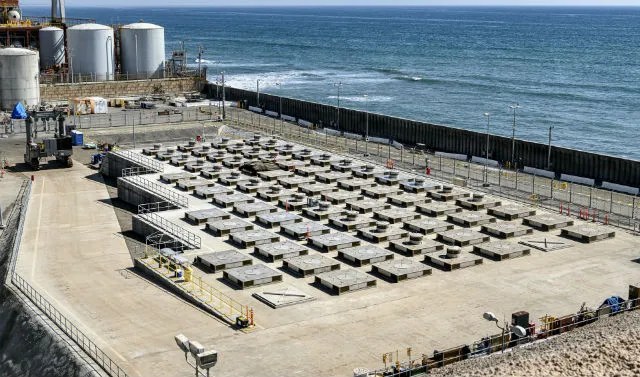**Southern California Communities Take Initiative to Protect Themselves from Nuclear Waste at San Onofre**
*By Sarah Mosko*
September 30, 2025, may mark a significant day for Southern California communities as they begin taking action to protect themselves from the dangers of nuclear waste stranded indefinitely at the decommissioned San Onofre nuclear plant. Irvine Mayor Larry Agran spearheaded this effort by convening a special study session of the Irvine City Council to address the risks posed by 3.6 million pounds of highly radioactive spent nuclear fuel stored in temporary canisters—exposed to the open air, located in an earthquake zone, and just 108 feet from the shoreline.
### The Safety Risks
The safety threats associated with the current storage include terrorism, sea level rise, earthquakes, tsunamis, and canister corrosion from exposure to moist, salty air. Many of the fission products in nuclear reactors, such as Cesium-137, are highly radioactive and extremely long-lived, necessitating isolation for hundreds of thousands of years.
Each of San Onofre’s 123 canisters contains roughly one-third of the amount of Cesium-137 released during the 2011 Fukushima nuclear disaster. These canisters were never designed for long-term storage and lack real-time monitoring capabilities for radiation leaks or structural degradation.
### Federal Inaction and Interim Storage Challenges
The nuclear waste will remain at San Onofre indefinitely due to the federal government’s failure to establish a permanent geological repository for the nation’s commercial spent fuel, despite legal mandates. In response, some lawmakers hope to persuade communities in Texas and New Mexico to host “consolidated interim storage” facilities until a permanent repository becomes available. However, these efforts have faced strong opposition from those states, wary of becoming de facto permanent waste dumps.
For residents near San Onofre, it is crucial to understand that even if an interim storage facility opens, the earliest possible date is between 2038 and 2040, according to the Department of Energy. Relocating all spent fuel could take decades longer due to competition from other nuclear plants aiming to transfer their waste. This means the nuclear waste will likely remain at San Onofre until at least 2060.
### Mayor Agran’s Proposal
In his opening remarks, Mayor Agran emphasized the responsibility of every level of government, including local jurisdictions, to protect their citizens. He called on Irvine to commission a plan to move San Onofre’s spent fuel into safer storage configurations until the federal government can assume custody.
Agran’s proposal includes relocating the canisters away from the shoreline, placing them on higher ground at Camp Pendleton, and storing them within a fortified building. This facility would protect against exposure to the marine environment, natural disasters such as earthquakes and tsunamis, terrorism, and be equipped to repackage the waste if canister failure occurs.
There is urgent need to relocate the waste while the canisters still maintain sufficient structural integrity for safe movement. Components of the proposal have received informal endorsement from several nuclear safety experts consulted privately by Agran and his team.
### Expert and Community Input
The study session opened with remarks by Dr. Gregory Jaczko, former chairman of the Nuclear Regulatory Commission. Dr. Jaczko expressed concern over the renewal of official permits allowing the spent fuel to remain stored as is, supporting local efforts to advance better interim storage solutions.
Next, Dr. David Richardson, a UC Irvine professor specializing in environmental and occupational health, provided insights into how radiation release would profoundly affect community relationships with their environment, including impacts on property values, gardening, and residential choices. Dr. Richardson agreed to assist in developing San Onofre’s safety plan.
Dan Stetson, chairman of the community engagement panel for the decommissioning of the San Onofre plant, described the panel’s role in facilitating public discussions—sometimes “spirited”—with Southern California Edison (SCE). While both the company and the public prioritize safe fuel storage and prompt removal, the panel supports finding communities willing to host interim storage facilities.
Representatives from Southern California Edison concluded the session. Frederic Bailly, Chief Nuclear Officer, asserted the company’s position that “the spent fuel storage is safe where it is,” and that “there is no credible scenario that could result in the release of radiological material beyond the site.” Conversely, Manuel Camargo, Principal Manager of Decommissioning, emphasized Edison’s strong support for “getting the spent fuel offsite” and highlighted the need for amendments to existing laws to facilitate interim storage.
### Public Response and Next Steps
The council chambers were filled with about 150 members of the public. Seventeen individuals provided comments, unanimously voicing concerns about leaving the spent fuel stored in its current state.
The session closed with moving testimony from Councilmember Mike Carroll, who recounted his experience exposing biohazardous government research in New York, which led to a laboratory shutdown. He detailed numerous shortcomings in the current storage of San Onofre’s spent fuel.
A council vote on Mayor Agran’s proposal is expected soon. His hope is that by Irvine taking the lead, other jurisdictions across Orange and San Diego Counties will join efforts to ensure safety for all of Southern California.
—
**About the Author**
Sarah Mosko is a trained neuroscientist and psychologist passionate about researching and writing on environmental challenges and solutions. She resides in Laguna Beach.
https://timesofsandiego.com/opinion/2025/10/18/opinion-cities-must-join-irvines-push-for-safe-storage-of-san-onofre-waste/




